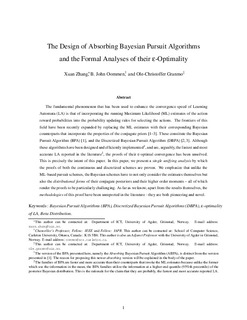| dc.contributor.author | Zhang, Xuan | |
| dc.contributor.author | Oommen, John | |
| dc.contributor.author | Granmo, Ole-Christoffer | |
| dc.date.accessioned | 2017-03-31T07:49:58Z | |
| dc.date.available | 2017-03-31T07:49:58Z | |
| dc.date.created | 2016-12-15T15:06:48Z | |
| dc.date.issued | 2016 | |
| dc.identifier.citation | Pattern Analysis and Applications. 2016, 1-12. | |
| dc.identifier.issn | 1433-7541 | |
| dc.identifier.uri | http://hdl.handle.net/11250/2436428 | |
| dc.description.abstract | The fundamental phenomenon that has been used to enhance the convergence speed of learning automata (LA) is that of incorporating the running maximum likelihood (ML) estimates of the action reward probabilities into the probability updating rules for selecting the actions. The frontiers of this field have been recently expanded by replacing the ML estimates with their corresponding Bayesian counterparts that incorporate the properties of the conjugate priors. These constitute the Bayesian pursuit algorithm (BPA), and the discretized Bayesian pursuit algorithm. Although these algorithms have been designed and efficiently implemented, and are, arguably, the fastest and most accurate LA reported in the literature, the proofs of their ϵϵ-optimal convergence has been unsolved. This is precisely the intent of this paper. In this paper, we present a single unifying analysis by which the proofs of both the continuous and discretized schemes are proven. We emphasize that unlike the ML-based pursuit schemes, the Bayesian schemes have to not only consider the estimates themselves but also the distributional forms of their conjugate posteriors and their higher order moments—all of which render the proofs to be particularly challenging. As far as we know, apart from the results themselves, the methodologies of this proof have been unreported in the literature—they are both pioneering and novel. | |
| dc.language.iso | eng | |
| dc.title | The design of absorbing Bayesian pursuit algorithms and the formal analyses of their ε-optimality | |
| dc.type | Peer reviewed | |
| dc.type | Journal article | |
| dc.source.pagenumber | 1-12 | |
| dc.source.journal | Pattern Analysis and Applications | |
| dc.identifier.doi | 10.1007/s10044-016-0535-1 | |
| dc.identifier.cristin | 1413588 | |
| cristin.unitcode | 201,15,4,0 | |
| cristin.unitname | Institutt for informasjons- og kommunikasjonsteknologi | |
| cristin.ispublished | true | |
| cristin.fulltext | preprint | |
| cristin.qualitycode | 1 | |
